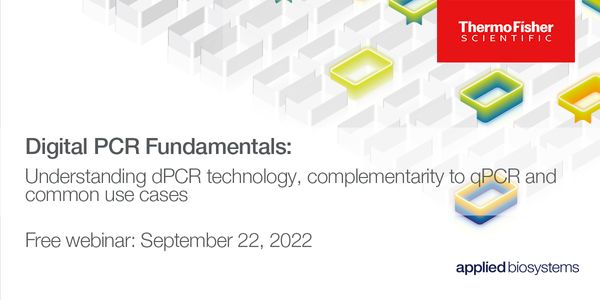Forensic Investigation
Forensic investigation refers to gathering and analysis of all physical evidence related to a crime in order to write a report and come to a conclusion about the suspect. The report details how the investigator thought the crime took place.
-
SEP 22, 2022 | 10:00 AMDate: September 22, 2022 Time: 10:00am (PDT), 1:00pm (EDT), 7:00pm (CEST) Digital PCR (dPCR) is a specialized approach to nucleic acid detection ......MAY 18, 2022 | 5:30 AMCurrent drug discovery workflows rely on the synthesis and bioactivity assessment of large compound libraries, both processes which heavily depend on high-throughput (HT) experimentation to...MAR 23, 2022 | 11:55 PMMost people are familiar with the main bioactive metabolites in Cannabis – cannabinoids and terpenes. The profile of each can be quite complex both in terms of numbers of different spe...MAY 05, 2021 | 9:00 AMThe success in the solving cases is based upon a system that emphasizes teamwork, from scene; recognition, collection, preservation, to laboratory; examination, identification , individualiz...MAY 05, 2021 | 7:30 AMGenealogist have long supported the legal system through probate work, heir searching, and by identifying next-of-kin of servicemen. Even though DNA was first introduced to genealogists over...MAY 05, 2021 | 12:00 AMThe postmortem microbiome is an emerging field in forensic science with broad application for death investigation (e.g., time since death). While the foundation for forensic microbiology beg...MAY 05, 2021 | 12:00 AMWhen violent crimes are committed, the crime scene is usually covered with blood. Blood may be shed when the person is standing, sitting, or on the ground. The weapon that caused blood to be...MAY 05, 2021 | 12:00 AMEvery day in America nearly seven thousand people die. That’s about two and a half million deaths per year. When a death is violent, unexpected, medically unattended, or suspicious &nd...MAY 05, 2021 | 12:00 AMThe detection and analysis of traces for the purpose of providing clues in criminal investigations has a rich history that dates back to the mid-18th Century. Traces are remnants of past eve...Speaker: Brooke Weinger Kammrath, Ph.D., D-ABCPresented at: Forensic Sciences Virtual Event Series 2021
MAY 05, 2021 | 12:00 AMResearch on decomposition odor has evolved significantly since the first introduction of this concept in the literature in 2004. This work is foundational to understanding several areas of f...DEC 03, 2020 | 12:00 AMThe fast spread and deadliness of SARS-CoV-2 has sparked much interest in understanding the underlying genomics and evolutionary patterns of this 30,000bp Coronavirus. Since the first report...JUL 01, 2020 | 12:15 PMHere I review the applications of Ion Torrent NGS technology in the field of microbiome research and some recent publications about it. With Ion Torrent 16S rRNA next generation sequencing,...JUN 17, 2020 | 4:30 PMThe fast spread of SARS-Cov-2 sparked much interest in understanding the underlying genomics of this 30,000bp Coronavirus. Thus far, thousands of genome assemblies are available, yet they fe...MAY 06, 2020 | 1:00 PMThe forensic investigation of crime involves answering four basic questions: who, what, where, and when. Tools exist to answer questions of who, what and where, but the question when is ofte...MAY 06, 2020 | 9:00 AMCrime scene investigation is more than just processing or documentation of crime scenes, nor is it just the collection or packaging of physical evidence. It is the first step and the most cr...MAY 06, 2020 | 7:30 AMThe toxicology of particulate matter is complicated by characteristics not normally encountered when addressing poisonings associated with chemical substances. Particle shape, surface reacti...MAY 06, 2020 | 12:00 AMThe potential for cognitive bias in forensic evidence interpretation and crime scene investigation continues to receive attention and debate within forensic and academic communities. Startin...MAY 06, 2020 | 12:00 AMHydroxychloroquine and chloroquine are long-standing antimalarial drugs recently brought into the spotlight as potential treatments for the pandemic-causing coronavirus (SARS-CoV-2). Notable...MAY 06, 2020 | 12:00 AMThe ever-increasing number of deaths along the U.S.-México border and the diversification in the demographic characteristics of the Latin American migrants, who perish in this region,...MAY 06, 2020 | 12:00 AMThe necrobiome is the community of organisms that use or are affected by decomposing organic matter. Decomposing organic matter comes in the form of dead plant matter (biomass) or that of de...APR 14, 2020 | 9:00 AMDATE: April 14, 2020 TIME: 9:00am PDT, 12:00pm EDT Besides being Gibco Cell Culture Heroes, what do Vivek, Sandra, Daisy, Ameet and Kristine all have in common? They are all stuck at home fo...Speaker: Kristine Wadosky, PhD , Ameet Chimote, PhD , Elizabeth Delery, PhD , Daisy Shu, B.Optom, PhD , Vivek Kamat, PhD , Sandra Hammer, PhDSponsored By: Thermo Fisher Scientific/GibcoSEP 27, 2019 | 9:00 AMDATE: September 27, 2019TIME: 9:00am PT, 12:00pm ET Thienopyrazole derivatives have recently emerged as effective antitumoral agents with kinase inhibitory activity. In this s...AUG 22, 2019 | 10:30 AMDNA profiling tools to teach undergraduate students about forensics generally utilize the PV92 Alu and D1S80 VNTR markers, but are both limited in scope. In contrast, advanced profiling syste...AUG 22, 2019 | 9:00 AMContemporary law enforcement has greatly expanded its ability to solve crimes by the adoption of advanced forensic techniques, electronic monitoring and new approaches in crime scene procedur...
SEP 22, 2022 | 10:00 AM
Date: September 22, 2022 Time: 10:00am (PDT), 1:00pm (EDT), 7:00pm (CEST) Digital PCR (dPCR) is a specialized approach to nucleic acid detection ......
MAY 18, 2022 | 5:30 AM
Current drug discovery workflows rely on the synthesis and bioactivity assessment of large compound libraries, both processes which heavily depend on high-throughput (HT) experimentation to...
MAR 23, 2022 | 11:55 PM
Most people are familiar with the main bioactive metabolites in Cannabis – cannabinoids and terpenes. The profile of each can be quite complex both in terms of numbers of different spe...
MAY 05, 2021 | 9:00 AM
The success in the solving cases is based upon a system that emphasizes teamwork, from scene; recognition, collection, preservation, to laboratory; examination, identification , individualiz...
MAY 05, 2021 | 7:30 AM
Genealogist have long supported the legal system through probate work, heir searching, and by identifying next-of-kin of servicemen. Even though DNA was first introduced to genealogists over...
MAY 05, 2021 | 12:00 AM
The postmortem microbiome is an emerging field in forensic science with broad application for death investigation (e.g., time since death). While the foundation for forensic microbiology beg...
MAY 05, 2021 | 12:00 AM
When violent crimes are committed, the crime scene is usually covered with blood. Blood may be shed when the person is standing, sitting, or on the ground. The weapon that caused blood to be...
MAY 05, 2021 | 12:00 AM
Every day in America nearly seven thousand people die. That’s about two and a half million deaths per year. When a death is violent, unexpected, medically unattended, or suspicious &nd...
MAY 05, 2021 | 12:00 AM
The detection and analysis of traces for the purpose of providing clues in criminal investigations has a rich history that dates back to the mid-18th Century. Traces are remnants of past eve...
Speaker:
Brooke Weinger Kammrath, Ph.D., D-ABC
Presented at: Forensic Sciences Virtual Event Series 2021
MAY 05, 2021 | 12:00 AM
Research on decomposition odor has evolved significantly since the first introduction of this concept in the literature in 2004. This work is foundational to understanding several areas of f...
DEC 03, 2020 | 12:00 AM
The fast spread and deadliness of SARS-CoV-2 has sparked much interest in understanding the underlying genomics and evolutionary patterns of this 30,000bp Coronavirus. Since the first report...
JUL 01, 2020 | 12:15 PM
Here I review the applications of Ion Torrent NGS technology in the field of microbiome research and some recent publications about it. With Ion Torrent 16S rRNA next generation sequencing,...
JUN 17, 2020 | 4:30 PM
The fast spread of SARS-Cov-2 sparked much interest in understanding the underlying genomics of this 30,000bp Coronavirus. Thus far, thousands of genome assemblies are available, yet they fe...
MAY 06, 2020 | 1:00 PM
The forensic investigation of crime involves answering four basic questions: who, what, where, and when. Tools exist to answer questions of who, what and where, but the question when is ofte...
MAY 06, 2020 | 9:00 AM
Crime scene investigation is more than just processing or documentation of crime scenes, nor is it just the collection or packaging of physical evidence. It is the first step and the most cr...
MAY 06, 2020 | 7:30 AM
The toxicology of particulate matter is complicated by characteristics not normally encountered when addressing poisonings associated with chemical substances. Particle shape, surface reacti...
MAY 06, 2020 | 12:00 AM
The potential for cognitive bias in forensic evidence interpretation and crime scene investigation continues to receive attention and debate within forensic and academic communities. Startin...
MAY 06, 2020 | 12:00 AM
Hydroxychloroquine and chloroquine are long-standing antimalarial drugs recently brought into the spotlight as potential treatments for the pandemic-causing coronavirus (SARS-CoV-2). Notable...
MAY 06, 2020 | 12:00 AM
The ever-increasing number of deaths along the U.S.-México border and the diversification in the demographic characteristics of the Latin American migrants, who perish in this region,...
MAY 06, 2020 | 12:00 AM
The necrobiome is the community of organisms that use or are affected by decomposing organic matter. Decomposing organic matter comes in the form of dead plant matter (biomass) or that of de...
APR 14, 2020 | 9:00 AM
DATE: April 14, 2020 TIME: 9:00am PDT, 12:00pm EDT Besides being Gibco Cell Culture Heroes, what do Vivek, Sandra, Daisy, Ameet and Kristine all have in common? They are all stuck at home fo...
Speaker:
Kristine Wadosky, PhD
, Ameet Chimote, PhD
, Elizabeth Delery, PhD
, Daisy Shu, B.Optom, PhD
, Vivek Kamat, PhD
, Sandra Hammer, PhD
Sponsored By: Thermo Fisher Scientific/Gibco
SEP 27, 2019 | 9:00 AM
DATE: September 27, 2019TIME: 9:00am PT, 12:00pm ET Thienopyrazole derivatives have recently emerged as effective antitumoral agents with kinase inhibitory activity. In this s...
AUG 22, 2019 | 10:30 AM
DNA profiling tools to teach undergraduate students about forensics generally utilize the PV92 Alu and D1S80 VNTR markers, but are both limited in scope. In contrast, advanced profiling syste...
AUG 22, 2019 | 9:00 AM
Contemporary law enforcement has greatly expanded its ability to solve crimes by the adoption of advanced forensic techniques, electronic monitoring and new approaches in crime scene procedur...






















